#breed: japanese harlequin
Text
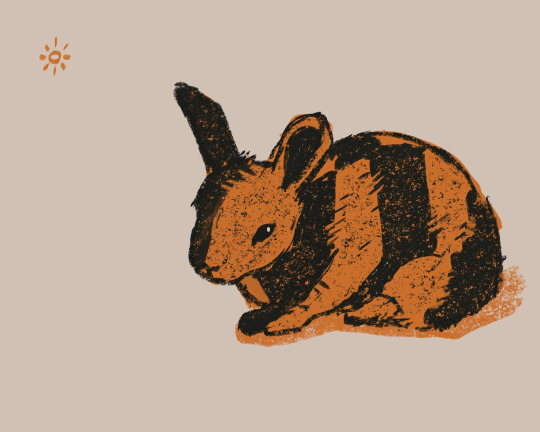
🐇 Mar 19 2023
#year of the rabbit#rabbit#bunny#artists on tumblr#daily rabbit#march 19#078#breed: japanese harlequin#these guys look so cool
211 notes
·
View notes
Text
A, B, C, D, E - Cat vs Rabbit
My comparative cat and rabbit color genetics post

Wild type (black agouti) rabbit and cat
My color genetics interest started out with rabbits, and while I know much more about cats now, they'll always have a spot in my heart...
In this post I'll go through the most important color genes, although sometimes I'll make comparisons based on phenotypes too.
All the photos are from the Warren Photographic Image Library.
A. Agouti
Both species have the dominant agouti (A) and the recessive self or nonagouti (a) alleles.
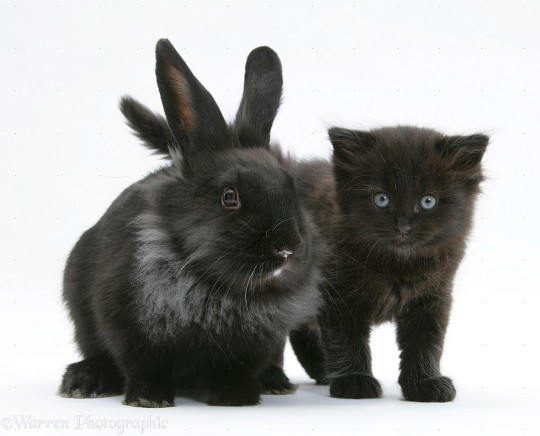
Black self rabbit and cat
Beyond these, cats add the charcoal (Apb) from the leopard cat, while rabbits have the otter or tan allele (at).
B. Brown
Black (B) as wild type, chocolate (b) as variant for both, and an extra recessive allele for cats: cinnamon (bl).
C. Color restriction
The most dominant allele of the series is the full color (C) for both species.
In rabbits the next is dark chinchilla (cchd), this gives the chinchilla and related colorations. Phenotypically basically the equivalent of silver tabbies in cats, despite silver (I) being a different gene. Chinchilla doesn't show up meaningfully on solid rabbits, so there's no smoke there.

Silver tabby cat and chinchilla rabbit. These are genetically very different colors, but manifest similarly: the animal loses the yellow-red pigments, and keeps the black.
The next rabbit allele in order of dominance is the sable or light chinchilla (cchl) which can be interpreted as the equivalent of sepia/burmese (cb) in cats, although they probably aren't the same mutation, because like the dark chinchilla allele above, sable has "silvering" effect on agoutis. Their shared characteristics are the slightly darker extremities and the intermediate interaction with the point allele.
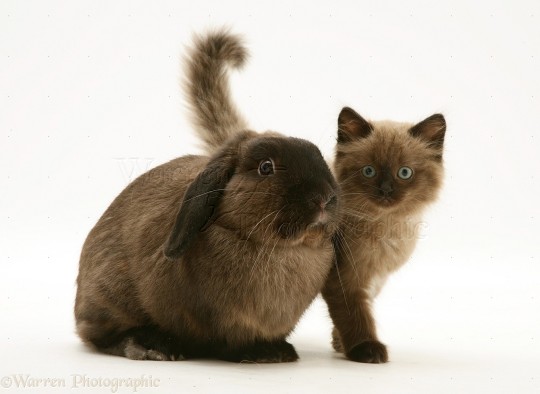
Sable rabbit and sepia (or possibly mink) cat
The colorpoint pattern is also present in both animals under the names siamese (cs) and himalayan (ch). It manifests as pale body with dark extremities.
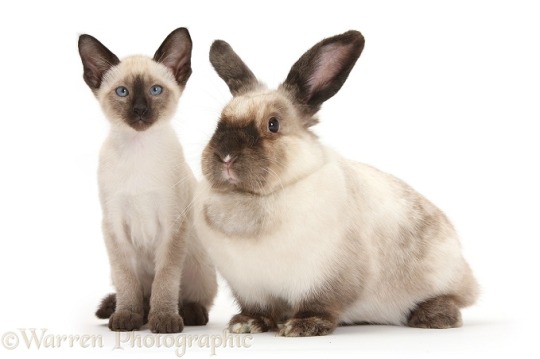
Pointed cat and rabbit
Edit: unfortunately I made a mistake here: while the color of this rabbit is indeed called point, it's not himalayan, it's nonagouti+sable+red. A real black himalayan rabbit looks like this:

Note the red eyes of the rabbit and the blue eyes of the cat - both suggest depigmentation.
Cats have a rare extra allele called mocha (cm).
And lastly, albino (c) is also present in both.
D. Dilute
Pretty much the same both genetically and in look. Dense (D) is dominant, diluted (d) is recessive.

Diluted (blue self) rabbit and cat
E. Extension
The mutations of this gene can be grouped into two categories:
increase of function: overproduction of black pigments. The animal is dark, melanistic. Dominant alleles.
loss of function: underproduction of black pigments. The animal is yellow/red. Recessive alleles.
Rabbits have two dominant alleles in the first group: full extension or dominant black (Ed) and steel (Es); cats have none. (Although this group isn't absent from the cat family either: black jaguars for example have a dominant black mutation.)
In the second group we have lots of different alleles: harlequin or japanese brindle (ej) and red (e) for rabbits, and amber, russet and copal/serdolik for cats (but their red is a different gene!). These all give different reddish phenotypes.

Red rabbit and cat - same name, similar color, different genetics.
The orange gene of the cats is an entirely different matter, and it's just a funny coincidence that harlequin rabbits look so similar to tortie cats. Brindle in rabbits is its own allele, not just the phenotype of the heterozygotes, and it's not sex-linked. Buck rabbits can be harlequins just as easily as does.
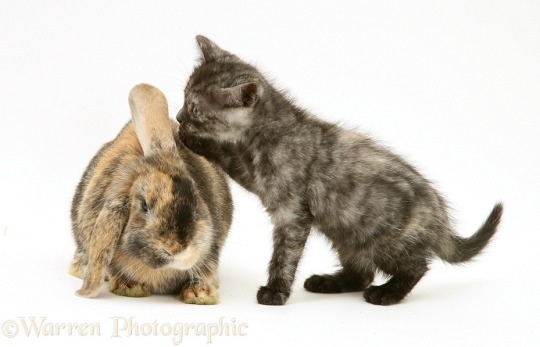
Harlequin rabbit and tortoiseshell cat - similar look, different name, different genetics
To make everything even more complicated, the word "tortoiseshell" (or shortly "tort") is used in rabbit breeding too, but it means a completely different thing than in cats: a nonagouti red. I assume because a nonagouti red rabbit (just like to the genetically very similar nonagouti amber cat) is darker than the agouti counterpart, especially on the extremities.
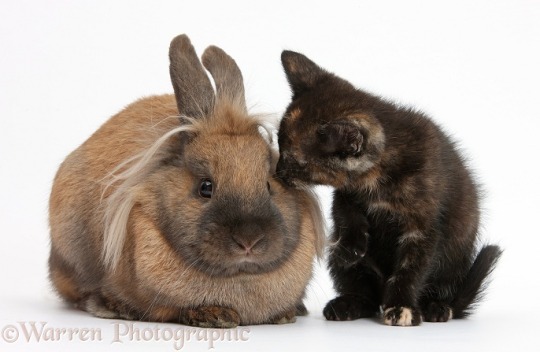
Tortoiseshell rabbit and cat - same name, different look, different genetics: bunny is a recessive homozygote for not sex-linked red, kitten is a heterozygote for sex-linked red.
+1. White spotting
Rabbits have three different white spotting genes: blue-eyed white or viennese, english and dutch. The latter two are strongly linked, the crossing over is rare. It's suspected that all three patterns are caused by mutations on the KIT gene. KIT is also the gene where all the so far known cat white spotting alleles: dominant white, white spotting and white gloving were mapped to.
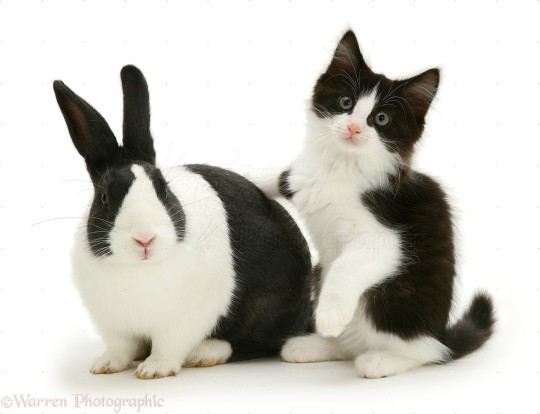
Black dutch rabbit and black bicolor cat. They are remarkably similar, aren't they?
Summary:

#cats#rabbits#cat genetics#rabbit genetics#now that i'm thinking about this sepia tabbies are quite pale too#ugh i love genetics
80 notes
·
View notes
Note
Kuro and Madara both seem like maine coons but Madara(and also Leo ) also give me calico vibes. Kuro also fits the norwegian forest cat.
Himeru is one of those freaky ass lanky oriental cats or a russian blue
Adonis is an egyptian mau or a siamese, Kaoru is an orange, Rei is a regular black cat but with weirdly shiny fur and Kouga is a cat who was raised by pitbulls and will not accept the reality that he’s not a pitbull
Keito is a regular european/domestic shorthair but with a weirdly green tint to it
I would say Mika is a khao manee due to the eyes but he is big eyed dark brown colored LaPerm( the specific image I have in mind is one of the pictures in The Cat Encyclopedia and I’m not even sure if it’s for that breed)
Tori is a munchkin
OK OKOK SO i actually already have breed hcs for everyone bc im so autistic abt cats i was gonna wait to talk abt them as i made the cat designs but progress is going really slow on those and now that someone is talking to me about it i cant make myself shut up . i agree with a lot of these !!! im just gonna go ahead and list all of my hcs though bc im insane (these are my somewhat realistic color hcs for what they would be if i didnt choose to make them all candy colored when i draw them lol)
(disclaimer: this is on appearance alone, not all these breeds and mutations are ethical, not all these colors actually appear in the breed stated or are combinations that dont exist, and some of these colors/breeds are extinct)
gonna put this under a readmore cuz its ...... a lot (i woulda added pics too but theres definitely way more than 10 cats here)
fine
eichi - ragdoll, cream point, important to note he is a purebred show cat
wataru - oriental longhair, blue bicolor harlequin
tori - munchkin/british shorthair, dilute calico
yuzuru - domestic shorthair (feral TNR), tuxedo, otter like coat texture
-------
trickstar
subaru - abyssinian, cinnamon
hokuto - american bobtail, black with blue undertones and low white
makoto - scottish fold, golden, non breed standard (longer face)
mao - ragamuffin, red with high white
-------
akatsuki
kuro - siberian, black smoke striped tabby
keito - domestic shorthair, brown mackerel tabby with low white
souma - japanese bobtail, brown broken mackerel tabby with high white
-------
eden
nagisa - maine coon, light gray sokoke tabby
hiyori - laperm, silver sunshine agouti with low white
ibara - chausie (feral), blue cream
jun - thai pisaat, black ticked tabby, kinked tail (pisaat characteristic)
-------
undead
rei - oriental longhair, black (looks brown in sunlight), long teeth (this isnt a mutation, some cats just have longer teeth than others— my design is inspired by mingus the panther, a black oriental shorthair that was popular on the internet for his huge fangs)
kaoru - turkish van, medium longhair, red chinchilla tabby/white
adonis - arabian mau, but with toyger coloration
koga - lykoi, dark gray/black roan, thinks hes a wolf due to being raised with dogs and the lykoi being known as the "werewolf cat"
-------
knights
leo - domestic shorthair, dense coat, medium white calico, long teeth
izumi - domestic shorthair, lilac striped tabby with low white
arashi - singapura, breed standard
ritsu - bombay, non breed standard (longer face) long teeth like rei but slightly shorter
tsukasa - ragamuffin, chocolate tabby with medium white, higher rufousing
-------
crazy:b
rinne - chausie, red grizzled tabby, high rufousing
niki - nebelung, non breed standard (shorter fur)
himeru - domestic shorthair, blue solid, small rounded ear mutation
kohaku - longhair american bobtail, sunshine lilac lynx point
-------
alkaloid
hiiro - chausie, red grizzled tabby (darker tabby than rinne), high rufousing
aira - ragdoll, cream point, non breed standard (shorter fur)
tatsumi - australian mist, silver spotted
mayoi - oriental siamese, seal tortie point, non breed standard (shorter face)
-------
rab*its
nazuna - somali, fawn, notably smaller than average
tomoya - domestic shorthair, fawn based caramel classic tabby
hajime - russian blue, breed standard
mitsuru - kurilian bobtail, chocolate solid
-------
valkyrie
shu - donskoy (brush), warm gray with white
mika - appears to be a kurilian bobtail, actually domestic longhair (medium), black heavy tortie, odd eyes and bobtail mutation (khao manee cats do have odd eyes, but can only be white. also mikas backstory lends itself to him being a randombred)
-------
2wink
theyre twins, so both are red classic tabby domestic shorthairs. theyre somewhat smaller than most cats .
-------
switch
natsume - domestic shorthair, red solid with minimal white
tsumugi - american wirehair, solid chocolate and white, non breed standard (longer fur)
sora - highlander, golden classic tabby with white, ringtail mutation
-------
ryuseitai
chiaki - havana brown, chocolate
kanata - turkish van, blue classic tabby/white
tetora - bengal/abyssinian, zorro mask charcoal bengal with high roufusing
shinobu - domestic shorthair, black/medium white spotted, somewhat short tail
midori - domestic (medium) longhair, fawn based caramel solid with white
-------
MaM and others
madara - maine coon, calico (my design for him is based off dawntreader texas calboy, a male calico maine coon that was the subject of controversy among cat show judges for being a genetic anomaly)
(madaras name actually means calico cat!! madara (斑) means spots and mikejima (三毛縞) means tricolored stripes, with "mike" often referring to calico and tortoiseshell cats. as a kid he also had the nickname "mikekun" in reference to his tendency to startle people by sneaking up on them silently like a cat)
anzu - british shorthair, chocolate tortie with medium white
jin - domestic (short) longhair (stray), dark gray, rough fur texture
akiomi - oriental longhair, fawn
kaname - british shorthair, blue solid, non breed standard (longer face)
#do NOT mention cats to me i WILL be insufferable#btw. i spent 3 hours on this#ask#anon#whiteboard#catstars
25 notes
·
View notes
Text



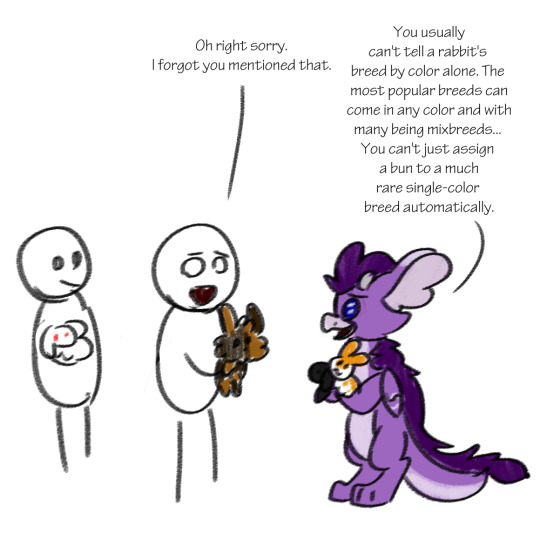


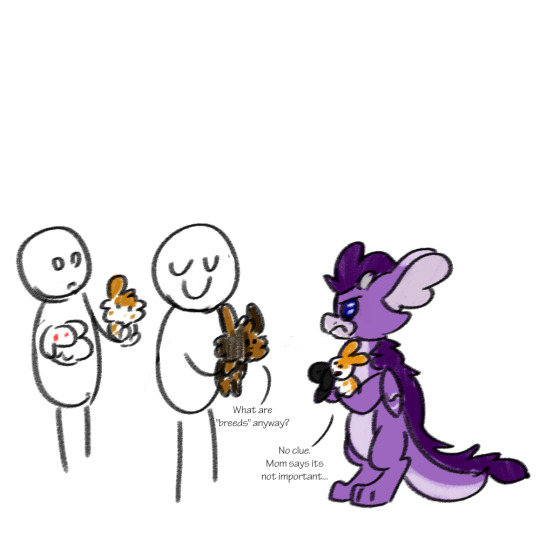
Sometimes I don't even know why I even bother..
Jason is right though, breed doesn't matter on bunnies... except that it means some of them may need more fur care than others... and also most pet rabbits are so mixed its impossible to tell what's even in then.
But people keep asking. And every single time someone's there to judge it by the color alone, no matter how obviously a lionhead it is...
Sometimes they'll also call anything a rex if the fur doesn't' feel like sandpaper...all rabbits have soft fur... rex fur is just special... and about half the rabbits I see identified as rex rabbits are really just random normal-furred mixes.
Then lately I've had someone go the other way with the color id... not identifying the spotted bun as an English Spot as they usually do... but call it a holland lop because they have spots sometimes... as do most breeds.
That's like noticing your rabbit has four legs, and identifying it as a horse, because they too have four legs...
Color is the least effective way to identify a rabbit's breed. Especially spots because they're extremely common.
The Dutch is another breed I have issue with because there just so happens to be a different marking that sometimes resembles dutch a lot (vienna marked) but they're not actually related at all... and yet I see people claim a white and black rabbit is OBVIOUSLY dutch or part dutch... even if it has blue eyes, which is a trait vienna marked buns sometimes have and dutch rabbits do not. Sometimes spotted rabbits are called dutch too, which again not related.
As for the harlequin I have never seen a purebred harlequin my whole life... And I've been to rabbit-shows.
What I have seen however are LOADS of dwarf rabbits with the harlequin (or Japanese) marking. I've even owned two of them. Both part lionhead, part lop, but they just so happen to have the Japanese marking. (And naturally I named one of them Harley Quinn...the other was named Kikki by her previous owner.)


Also guest starring my current bunnies Jason Todd the English spot Netherland dwarf and Frøya the Alaska Holland Lop.

#rabbit#usagi rants#ryuusagi comics#bunnies#Also please don't use this comic as a guide on how to hold bunnies :p#I would not recommend carrying two at once...#nor holding a baby in one hand like that second guy is doing
4 notes
·
View notes
Note
Top five bunnies
Fictional Bunnies: Bunnie Rabbot, Bigwig, Bunnicula (book version), Rabirin, and Coco
Bunny Breeds: blanc de hotot, Japanese harlequin, minilop, Flemish giant, Rex
5 notes
·
View notes
Text
Rare Exotic Feline Registry

Rare Exotic Feline Registry
REFR accepts the following breeds of cats for registration.
Abyssinian – ABY
Alpine Lynx – ALP
American Bobtail -ABT
American Curl – ACL
American Keuda – AKE
American Fold Shorthair-AFS
American Fold Longhair-AFL
American Straight Shorthair-ASS
American Straight Long Hair-ASL
American Lynx – ALX
American Miniature Cat – AMC
American Polydactyl – APD
American Longhair – ALH
American Shorthair – ASH
American Wirehair – AWH
Asian – ASN
Asian Leopard Cat – ALC
Australian Mist – AMS
Balinese – BAL
Bambino – BBO
BamBob – BMB
Bambino Curl – BBC
Bengal – BGL
Birman – BIR
Bobcat- BCT
Bombay – BOM
Bramble – BRA
Brazilian Shorthair – BZS
Bristol – BRI
British Longhair – BLH
British Shorthair – BSH British Ice Longhair-BCL
British Ice Shorthair-BCS
Burmese – BUR
Burmilla – BML
California Spangled – CSP
California Toyger – CTO
Caracal – CRL
Chartreux – CHX
Chausie – CHA
Chinese Harlequin – CHQ
Chinese Tank Cat – CTC
Color Point Shorthair – CSH
Copper – COP
Cornish Rex – CRX
Cymric – CYM
Curly Tail Cat – CTL
Desert Lynx – DLX
Devon Rex – DRX
Donskoy – DSK
Dossow – DOS
Dwelf – DWF
Egyptian Mau – EGM
Exotic Shorthair – ESH
Elf – ELF
Experimental – EXP
Fishing Cat – FCT
Foldex – FEX
Gao Taem – GTM
Genetta – GEN
Geoffroy’s Cat – GRY
German Longhair – GLH
Havana – HAV
Hemingway Curl – HCL
Hibernian Lynx- HBL
Highland Fold – HFD
Highland Lynx – HLX
Highlander – HDR
Himalayan – HIM
Jaguarette – JGR
Jaguarundi Curl – JAG
Japanese Bobtail – JBT
Javanese – JAV
Jungala – JLA
Jungle Cat -JCT
Junglebob – JBB
Jungle Curl– JCL
Jungle Lynx – JLX
Khao Manee – KMN
Kinkalow – KKL
Korat – KOR
Lambkin – LMK
LaPerm – LAP
Maine Coon – MCN
Manx – MNX
Meerkat – MKT
Minskin – MSK
Mohave Bob – MHB
Mokave Jag Cat – MJC
Mojave Spotted – MJS
Mountain Bobs – MTN
Munchkin – MUN
Napoleon – NAP
Niebelung – NBL
Norwegian Forest Cat- NFC
Read the full article
1 note
·
View note
Note
Are cat genes similar to rabbit genes? since they both have similar patterns?
Aside from the agouti gene, not really.
Inhibitor seems to work different, as I have a rabbit that would be a smoke in cat terms, but she's not silver in rabbit terms. She's just... Normal in rabbit terms lmao. A silver rabbit (progressive loss of pigment on the hair shaft) is WAY different than a silver cat (no pigment in the hair root since birth)
Red also works different, as it's not sex linked. Harlequin (black/red) rabbits are very common, and it's a pattern to breed for in certain breeds (Rhinelander, Harlequin (US)/Japanese (EU), Dutch, Gotland, Magpie (but that's with more genes added), Holland Lops, etc.
The Longhair genes are also obviously different. In cats it's also polygenic, tho often shortened to L/l only. In rabbits the Longhair genes are all very different and all result in very different fur types (Angora = puffy, Swiss Fox = true Longhair, Lionhead = area restricted longhair) but they do both have rex.
35 notes
·
View notes
Text
What Pet I Think They'd Have and Why: Karasuno Edition
Daichi Sawamura

Of course he'd have a police dog
He's a cop and if he'd have any pet he'd have a buddy to help him bust criminals and fight crime
But I don't think Daichi would have a "normal" dog breed like a German Shepherd, Malinois, or Akita
I feel like Daichi would have a Rottweiler not bc they are my favorite dog breed
But Rottweilers used to be very prevalent in many police forces around the world until German Shepard and Malinois became more common
Also Rottweilers gained a harsh reputation for being aggressive bc they were trained by drug lords and criminals and were used to in fighting
Rottweilers are very muscular, sturdy, and hard working dogs
If trained right and with proper love and care these dogs are GREAT and I mean GREAT companions
They are stubborn and can be territorial with strangers, but, they are very loving towards familiars and family
They are a kind of one or two people fits them kind of dog
They also need constant stimulus as they were breed to be very hardworking dogs
Rottweilers used to pull sleds full of butchered meat bc they were so strong and the original breed was much bigger than the one we know today
They also herded large livestock through the alps and Roman region and are known to be fearless
They are also one of the oldest dog breeds
These dogs became popular Police dogs during the World Wars
Bc they were being used so much their guardian qualities were more showcased so more and more people wanted one to help keep and eye on their children
Since they are herding dogs they are good around children and can keep them in a yard if they are taught the parameters
Rottweilers despite their size generally don't bark a lot either, they are very sneaky when approaching a possible threat and will ppun e from behind
This is why I think Daichi would have one to be by his side
I feel like Daichi would do a lot of research into a good companion and finding a good breeder to find one after deciding
He'd get one as a puppy and personally see to it's training, working with a pro the whole time
His dog would also be a great family protector when he's home with his spouse and possible children, if he ends up having any
Koushi Sugawara
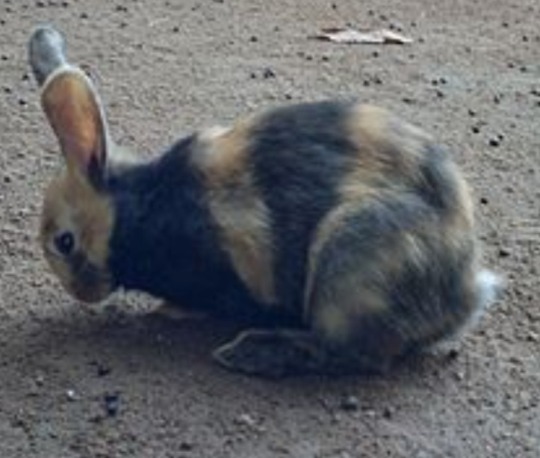
I feel like Koushi would be that really awesome teacher that has a really sweet and sociable pet that he brings in for the kids a lot
I feel Koushi would want soemthing small and cute so a rabbit of some sort would suit him well
Rabbits can be very loving with a small family most of the time or sometimes only one person
Rabbits are prey animals so some breeds wouldn't do well in a loud room full of young children
So what specific rabbit breed would suit his job?
So I chose the Harlequin Rabbit for Koushi
Harlequin rabbits are very social and loving towards owners and strangers alike
They also are known to be very silly, playful and very intelligent
They come in two colour types: Japanese and Magpie
The picture above is an example of Japanese while a Magpie can be colored in just about any other colour other than black nd orange like lilac, white, chocolate, blue and/or black
I feel like this specific type of rabbit would suit him so well as it would be comfortable around all those kids
Be very social and would be less likely to nip them
And it would be energetic enough to keep up with the kids
Koushi wouldn't just want a pet for his classroom though, he'd want a cuddle buddy for at home
He'd want a companion to sit on his lap while he works on lessons
He'd also want a pet that wasn't too lazy as his life would be pretty busy
The only thing is is that rabbits are high maintenance and need very specific foods, medicines, and an experienced vet to care for them
But rabbits are cuddly little crackheads that Koushi would adore
Energetic enough to keep up with his life, but snuggly and home bodied enough to not exhaust him
Asahi Azumane

Asahi is a fashion designer and thus would spend a lot of time hunched over a sketch book making designs
In other words, he has a very home based and indoor job
So he'd need a pet that isn't energetic and obnoxious like a husky or chihuahua
So I chose the Havanese
Havanese is the national dog of Cuba
This dog may be small but they are incredibly sturdy
These dogs become attached quickly and are extremely loyal to said lone owner
Something else that is good for Asahi is these dogs do not do good alone and are willing to follow their owners to the ends of the Earth
They can be described as velcro dogs bc of how attach to the hip with their owners they are
These dogs can be lively and active but they don't need much exercise as they are smaller
Most of their daily exercise can be met in a house with some light play
Also, these dogs are extremely friendly towards strangers and can be described as good host dogs
Another plus for Asahi about this breed is they aren't particularly vocal, most are rather quiet and reserved almost
The last thing you'd want is for people to look down on you for letting your pet act spoiled by barking and nipping at people's ankles
They also love to perform for others
They like attention and are good in groups
Asahi would have to meet with a lot of new people like models and companies and whatnot so a social dog would be best
Asahi also would spend a lot of time in an office or at home and since these dogs don't need much exercise he would be able to have it sleep on his lap while he works without disturbance
I also feel like Asahi would become a bit of a hermit
Like he would contact people but he wouldn't leave his house unless he absolutely had to or wanted to (which isn't often)
Havanese are home-bodied dogs and love just chillin' out on a warm lap or on a couch cushion beside their owners
Yū Nishinoya
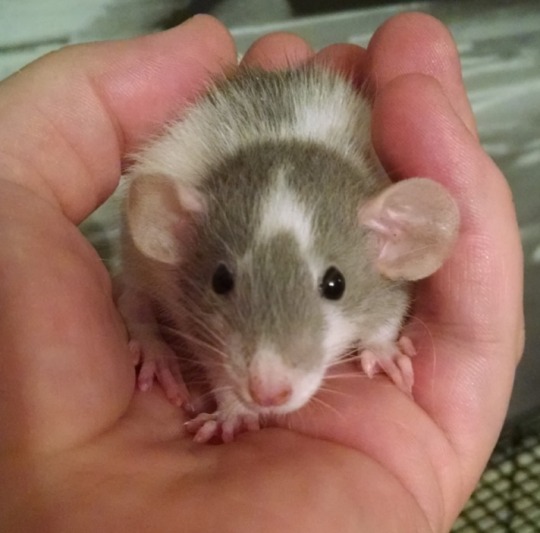
Now I DO NOT think Noya should have a pet until he decides to settle down somewhere
Travel can really exhaust a person so it would harm an animal tenfold
So, if you travel a lot DO NOT GET A PET IT WILL ONLY HARM THEM
But if Yū were to have a pet.............................
Noya would need a pet that can travel well, is small enough to not cost a lot, is very attached to their owners, and can eat just about anything
I thought briefly of other rodents since rodents are generally small and can eat just about any food
But raccoons, possums, and other larger rodents that are more common for pets would be too hard to get on planes and boats since you need certification to own them
Rats on the other hand don't need such certifications in most countries and fill all the other requirements
The rat he would have isn't a Dumbo rat like in the picture above, he'd have like a wild rat that he befriended and decided to take with him so it'd most like be brown
Noya would 100% fight anyone who says they hate rats
He hypes up his pet rat to no end
He calls Asahi whenever he can and tells him about all the cool stuff his rat does and sends pictures of his rat being held up to a gorgeous background of famous landmarks in other countries
Nlya always has his rat around the back of his neck and wears a hoodie, scarf, or something like that to hide him so he can join Noya in places that don't allow pets
I also chose a rat bc they are incredibly loyal and I feel like if Noya were to be really tired on a plane and pass out, he would need a pet that he wouldn't have to worry about running away
Of course he has trained his rat to do amazing tricks, you already know
Also, as I previously mentioned, rats can eat just about anything, so his constant travel wouldn't hurt his companion diet
Rats are also quiet generally and aren't overly energetic so he wouldn't have to be worried about being escorted out for having a rat under his scarf
Chikara Ennoshita
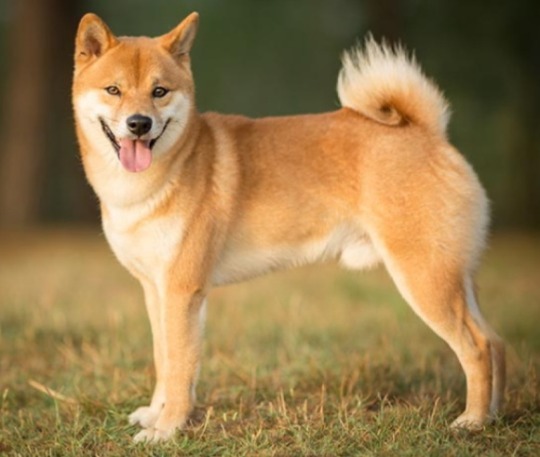
Shibas are very independent dog, let's just start with that bc Chikara would need a pet that doesn't need constant attention
With him being a personal trainer he needs a pet that can self entertain
Something else about Shibas is they can often housebreak themselves bc of how fussy and finicky they are
You can also find them cleaning themselves much like a cat
Chikara would be busy for a good bit of his time so he doesn't really have time to properly spend time to housebreak a pet
But Shibas were originally bred to hunt and flush out game like birds and rabbits and other such small animals
A fact about Shibas is they almost went extinct during WWII bc of food shortages a distemper
Distemper is a disease only animals can be affected by that attacks many different systems in their bodies
Also, Shibas are the number one most common companion dog in Japan
Something else about Shibas is that they are fairly healthy, some of the more major problems they have are glaucoma, cataracts, hip dysplasia, entropion, and luxating patella
A lot of eye conditions but are easily avoided if you bring them in for very periodic eye checks and hip examinations
So these are easy to avoid as long you keep an eye on them
Over all I think that if Chikara were to have a pet it would need to be fairly self-sufficient but also something could have a very chill and laid back relationship with
Something that doesn't need to be on his lap all the time but something he can love and nurture
Kiyoko Shimizu & Ryūnoske Tanaka

Now I know I know
Ryu would be a dog person
He'd want a big manly pet not a cat blah blah blah
Kiyoko would definitely be a cat person
She wouldn't want a purebred and would probably find a box of some kittens with Ryu on the side of the sidewalk
Now look me in the eye and lie to me by saying that Ryu would now start crying immediately upon seeing like four lonely little kittens in a box that need a home
Needless to say, they take them home and nurture them endlessly
But Tanaka would be the kind of guy that harness trains his cats so they can go out on walks
Kiyoko would research how to harness train them, what food would be the best, and anything else they need to take care of these four cats
Imagine seeing these two, a big muscular dude and this goddess walking four cats on harnesses down the street
I literally cannot stop thinking about Ryu and Kiyoko cuddling on the couch with all four adult and rather large cats draping themselves across the two of them
I feel like the reason Ryu would want them harness trained is bc he wouldn't be able to spend much time with them
His job as a personal trainer would keep him busy
So on his morning jogs to stay fit he'd want to take not only Kiyoko but the cats as well
I plan on making more parts to this, I hope you enjoy it 😉
@popcorntime-doodles @multifandombrainrot @kneecapstealingalien @akabxne @jiheonity @weareallhumans123 @smallmangi @canadian-crow @just-jellyfish @immiamarais @i-need-coffee-now-pls @foreveryoung050 @kuroos-world @luminasapphire @silverfire6 @shadowsbutdead @ghostexhibit @simpfornishinoya @goshikisimp @anothershadeofpink @mestayanon @japoga @all-around-fandoms31 @thatfunnysprout @myyeetfelloff @itsallgonnabokayihope @g00s3 @boreateo @mirrorballmyfave @backalley-astrologer @vaniatslover @lil-mellow-bunbun @strawberrymakki @theforbiddenrealm-blog @beelziee @mehreenlol
#haikyuu headcanons#haikyuu!!#daichi sawamura#sugawara koushi#asahi azumane#yu nishinoya#ennoshita chikara#kiyoko shimizu#tanaka ryuunosuke#daichi headcanon#suga headcanons#asahi headcanons#nishinoya headcanons#ennoshita headcanons#kiyoko headcanons#tanaka headcanons
76 notes
·
View notes
Text
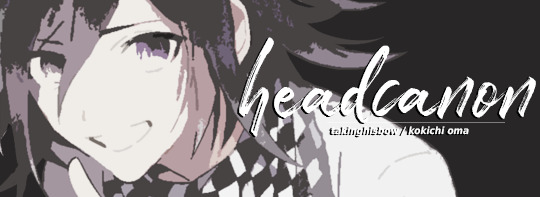
[places head in hands] His cat’s name is Beignet.
She’s an orange and white, harlequin, and shorthair Japanese bobtail. She has heterochromia (one blue/”silver” eye and one gold eye). As is common with the breed, she’s super active and enjoys going outside on a harness and leash. She loves playing with humans and can be kind of a menace at times. Once she gets to know other people, she gets very attached.
#guess who has to write a post abt kok.ichi knowing multiple languages including french now [sobs]#anyway i'm kidding i would die for beignet#listen i wasn't gonna do heterochromia but APPARENTLY it's more common in this breed than most cat breeds#and i just went 'hrngh beta!kok.ichi vibes' and decided#˖ ✧ ends / means » ( headcanon )
6 notes
·
View notes
Text
Tips On Simply how To Decide Your Rabbits Breed

I simply needed to have my outside dwarf Rex rabbit put to sleep this afternoon after suddenly getting very sick and I couldn’t find a vet that knew about rabbits before she received worse. I’ve had her for six years and once I obtained her from some folks they informed me that she was very old, about 8-10 is what they said. She was one of the best pet bunnies I even have ever had and the only one I’ve had that may “talk” to me, by making a lot of noises each time I held and cuddled her. They are highly meat and fur productive and really suitable for business farming.
Then organize their water, hay feeder, and litter field inside the house.
To be taught extra about rabbit care, visit House Rabbit Society at rabbit.org.
She would nestle within the dust surrounded by a miniature forrest of oregano leaves.
Weighing in at solely 2.5 lbs, the Netherland Dwarf is doubtless one of the smallest rabbit breeds. With a brachycephalic head, short ears, and large eyes, there’s no dispute about their cuteness. The Netherland Dwarf may be skittish, however, so they’re not beneficial for young children. But with the best household, this sweet little bunny will come out of their shell.
Blanc De Hotot Rabbit
Rabbits want a way to get off the hard wire of the cage every so often, in any other case they may develop sore hocks. They promote resting boards on the pet provide shops, or they are typically included with the cage. You can also use an old scrap of carpet or a bit of toweling.
How much does a pet bunny cost?
If you decide to buy a bunny at a pet store, you could spend up to $40 for an average rabbit. Show rabbits and rare breeds can cost over $100. The shelter or pet store should inform you whether your new bunny has been spayed or neutered.
This breed of rabbits has quick fur and is a superb beginner-friendly rabbit. They look attractive for his or her purple coat and don’t require much grooming because of the brief length of their hairs. These rabbits are small in measurement and perfect as indoor pets. So I guess as a beginner pet rabbit owner, you won't wish to adopt dwarf rabbits. Not adopting dwarf rabbit breeds will forestall you from the bills of visiting a veterinary a number of times a year. This is undoubtedly one of the in style rabbit breeds on the planet.
Litter
You should all the time meet a rabbit in person a quantity of instances and spend time holding and interacting with it earlier than deciding to adopt it. Even if a breed is thought for having a friendly temperament, a person rabbit could display behavioral points depending on its historical past. For instance, a rabbit that's only about a foot long should not want a cage more than two toes in size. A rabbit that is three feet long might have a really massive cage, which can be exhausting to slot in a smaller space.
What is the smartest bunny breed?
Popular opinion does claim that some breeds are smarter than others, though. For example, Mother Nature Network describes the Belgian Hare as the smartest domesticated rabbit. The Harlequin Rabbit is also frequently described as among the most intelligent lagomorphs.
There are literally 4 different varieties of wool found on various kinds of Angoras. A lot of rabbit owners with Angora coats choose to keep their coats cut brief for simpler care. Angora fur shouldn't be clipped right up to the skin because the coat provides natural safety in opposition to warmth, chilly, and something that will injure the pores and skin. Be sure to go away a minimal of 1 inch (2.5 cm) in length to the coat. Rabbits, like cats will groom themselves, nonetheless in doing so they are susceptible to hair balls.
The Japanese rabbit is orange or fawn and either black, blue, chocolate, or lilac. The Magpie is white and both black, blue, chocolate, or lilac and each varieties are around ten pounds of beautiful beauty. This provides the rabbit a safe place from which to see, hear and scent all that is happening. Housing a rabbit in a child’s room or an extra bedroom, the place there are sporadic bursts of exercise, may actually delay the rabbit’s adjustment to normal household life. [newline]Finding a skilled rabbit veterinarian could be tough.
youtube
1 note
·
View note
Note
What's your favorite rabbit coat colors? Favorite doe you currently own? Funniest rabbit story?
favourite coat colours....i am a big fan of both japanese and magpie harlequin, harlequin dutch, super steel, and tort. black otter is really nice too but i am not a fan of it in coats that aren’t rex, but rex tend to have bad rufous so it’s a trade-off.
favourite doe i currently own is obviously rosette. my favourite doe NOT in the old bat home is a toss between georgie, cloud nine, and spooky? georgie cos she’s super sweet like her mom, cloud nine because she’s HUGE, and spooky because i like that she has a personality lol.
funniest rabbit story is probably the cocopuff affair, that i talked about in a post a couple days ago. my friend owned her for a YEAR and neither of us realized she was a doe, not a buck. no wonder she never really wanted to breed with any of the does we gave her.
second funniest probably is the time that i culled a rabbit and was holding it while it went through its death throes and i wasn’t hold it tight enough so it rocketed out of my arms and started doing cartwheels across my yard. which, at the time, i lived in a trailer park with many many children. fortunately i don’t think anyone saw me chasing a dead rabbit around like a crazy person and no children were traumatized, but it still was An Event.
11 notes
·
View notes
Photo
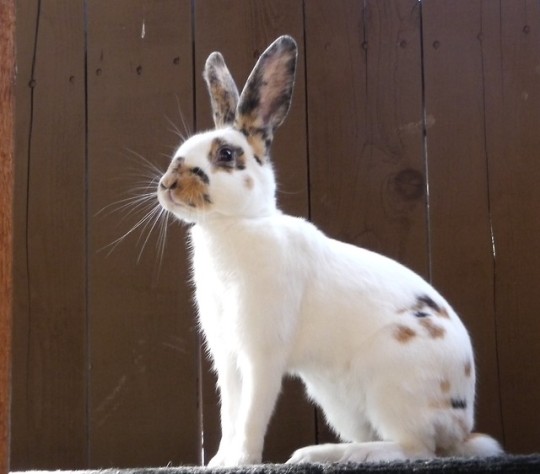
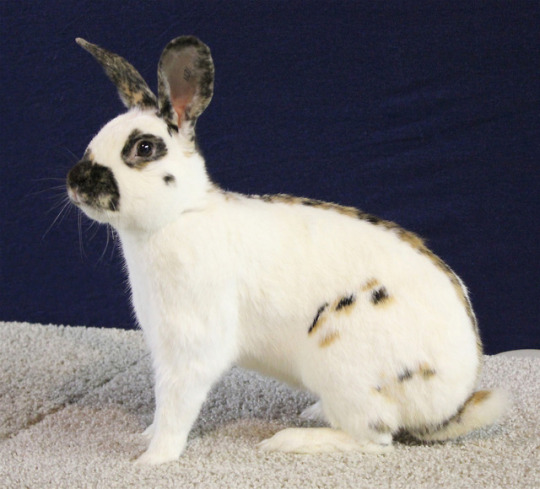
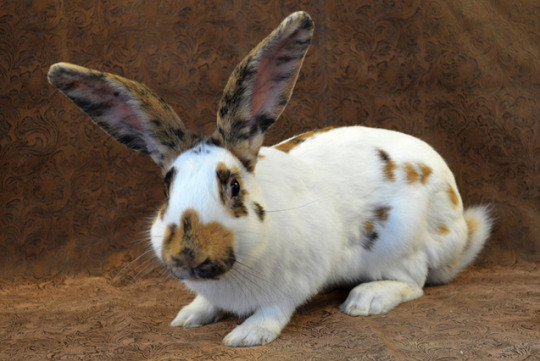

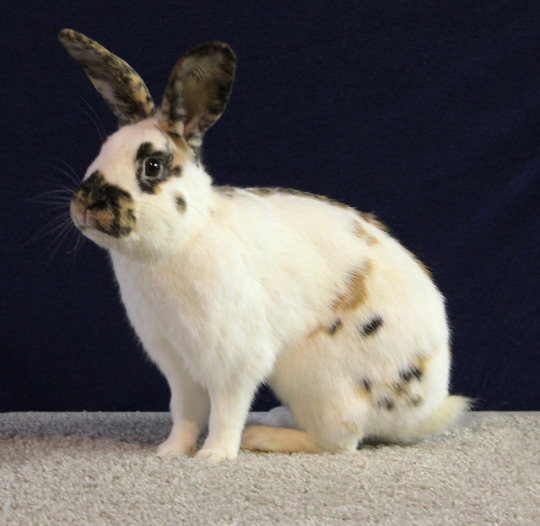
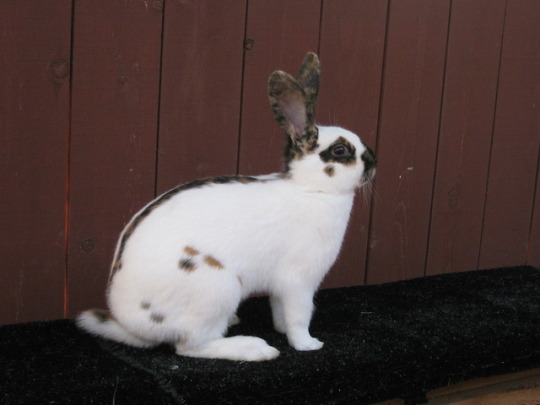


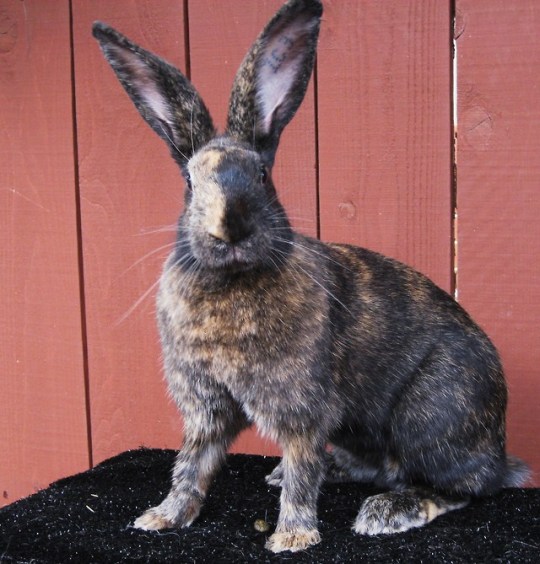
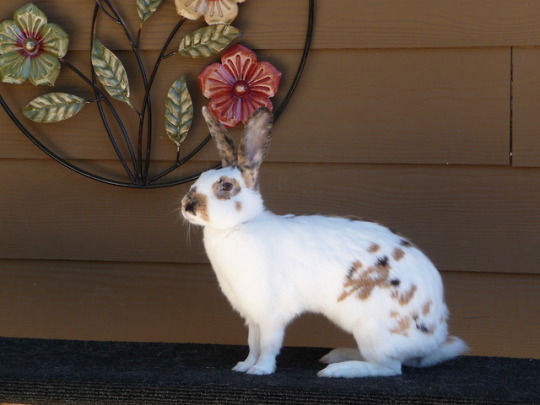
The Rhinelander is a medium-sized breed of domestic rabbit that originated in Germany. Rhinelanders are known for their distinctive facial "butterfly markings", a spine marking, colored ears, cheek spots, eye circles and side markings (on a white background) of black with orange or of blue with fawn. The Rhinelander breed is recognized by the British Rabbit Council (BRC) and by the American Rabbit Breeders Association (ARBA).
The Rhinelander is an arched breed of rabbit, meaning that light shows between its body and the ground when the rabbit is sitting or moving. The Rhinelander has a trim athletic appearance, with the body being the same width from shoulders to hip. The Rhinelander is known for its distinctive coat pattern and for its "butterfly markings" which cover the nose and upper jaw in a shape resembling a butterfly. British standard calls for a weight of 6 to 10 lb, while the American registry prefers a weight of 7 to 9 pounds.. The only color pattern recognized by the BRC is a white base colour with black and yellow markings on the face and back; however, ARBA recognizes a blue and fawn spotting pattern on a white background, in addition to the black and orange pattern.
For many years the only marking color accepted was black/orange. However, in 2012 blue/fawn Rhinelanders can be shown and earn ARBA Grand Championship status for the first time. Lorena Ferchaud of Rough and Ready, California, developed the new color through many years of selection. She introduced the blue variety with blue Japanese Harlequins, because the Rhinelander is genetically a broken harlequin.
The body type is full arched: long-limbed and carried with grace in order to show off those beautiful markings. Rhinelanders are not posed, but like others in the full arch category, they run the length of the table during judging.
The Rhinelander first appeared in shows in 1902 in Germany, after initially being bred in North Rhine-Westphalia. They were developed from a cross between a Harlequin buck and a gray papillon type doe. A buck from the litter had the markings that the Rhinelander would come to be known for - black and orange in color, located on the chin, ears and "butterfly markings" in black on one side and orange on the other. Another cross was made between the Harlequin buck and a Checkered Giant doe, with the resulting litter producing a doe with the desired markings. The buck from the first litter and the doe from the second litter were mated, and does from the resulting litters were crossed with Harlequin bucks to create the Rhinelander breed. In 1905, a German breed standard was created, and they were given the German name "Rheinishe Schecke". In 1924, the first rabbits were exported to the Netherlands and England. Although initially very popular, the initial interest soon dwindled, along with breeder numbers. Interest reemerged in post-World War II Germany, however, and population numbers again grew, with the Rhinelander becoming the most popular spotted breed in the country by 1978.
After the first exports from Germany to the US in 1923, the Rhinelander was recognized as a breed in the US by the National Breeders and Fanciers Association. By 1932, however, none remained in the US, likely due either to the difficulties of meeting the breed standard or to greater breeder interest in the Checkered Giant rabbit. In 1972, an American breeder visiting West Germany saw the breed at a show and returned to the US with four Rhinelanders. In 1974, the Rhinelander Rabbit Club of America was created, and in 1975, the breed was acknowledged by the American Rabbit Breeders Association. Some breeders crossed Rhinelanders with Harlequin or Checkered Giant rabbits to improve the stock. In 1994, the American breed standard was rewritten and clarified, and interest in the breed continued to grow. The Livestock Conservancy currently places the breed at "watch" status, meaning there is a global population of less than 2,000 and fewer than 200 registrations in the US each year. In Britain, the Rhinelander breed is currently designated as a member of the BRC's "Rare Varieties Club".
[x]
175 notes
·
View notes
Note
what if alonzo was a Japanese bobtail cat? that would be pretty interesting, can it be done?
i love hearing hcs about the types of cat all the Jellicles are! Alonzo as a Japanese bobtail is one that I hear quite a bit, and i can definitely see it!
i usually tend to just use "harlequin" as a description for Alonzo, i never really have a specific breed in mind for him!
(though i would be happy to talk abt my other hcs for what breeds the members of the Jellicles are 👀)
0 notes
Text
Harlequin Rabbit Characteristics
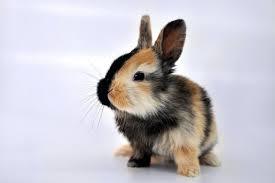
The Harlequin bunny is among the oldest forms of rabbit, that was designed in France in the 1880s. It's a breed instead of a body and fur type.
Placing with the Tortoiseshell Dutch bunny with rabbits that were wild designed the Harlequin bunny.
The Tortoiseshell Dutch rabbits were popular. Back in 1887, the Harlequin rabbits have been shown in events in Paris along with the strain made it shorty then.
Due to their markers, the strain was a series creature in England. And the strain became popular as a meat animal.
Many fanciers imply that the Harlequin bunny is really not a strain. It is color kind. But others assert it is a strain of rabbit with this color scheme.
https://www.youtube.com/watch?v=Z4IFQcDb8PU
The Harlequin bunny was known as the 1920s in the USA. Possibly this Harlequin rabbit breed's name was that the Japanese.
However, that title was dropped through the World Wars. Now, the Harlequin breed is well known by the American Rabbit Breeder's Association and the British Rabbit Council.
Harlequin Rabbit Characteristics
The Harlequin bunny comes in 2 types; Western and Magpie. The Harlequin rabbits are and orange black, green, blue or lilac.
Along with also the Magpie Harlequin rabbits are and white rather than orange black, chocolate, blue or lilac. Both kinds are moderate in size with a mind. Their ears are of moderate length and stay vertical.
An ideal Harlequin rabbit is going to be divided between both colors around the head, toes, body, and ears. It seems like a stripe between the 2 colors.

A few Harlequins may have white or black orange bellies. It's a rabbit breed. Their figure wight is between 2 and 3 kg.
And like nearly all bunny strains, the will not be heavier than the dollars. The main colorways of this Harlequin bunny are black, blue, lilac, chocolate (all blended with orange) and dark, blue, lilac, chocolate (all blended with white).
The strain is short-haired. Along with the jacket is compact and soft. Photo in Wikipedia.
Harlequin Rabbit Advantages
Presently the Harlequin bunny is principally maintained as a show animal. Nevertheless, they were famous for beef production. And excellent as pets. The strain is acceptable for kids.
The Harlequin bunny is a smart, docile and lively breed. It is a breed that is good-natured. It's regarded as pets for children and calm in nature.
The Harlequins are smart and can be trained to find out their title. They're proven to be much more apt than hamsters and guinea pigs.
They want things to climb, crawl, dig and dig and are lively. Even though the strain is treated and secure for kids, but an adult must supervise handling and the maintenance of their rabbits.
This Harlequin rabbit's lifespan is up to 5 years.
Harlequin Rabbit Breed Information
Breed NameHarlequinOther NameJapanese, MagpieBreed PurposeMainly kept as a show animal, also suitable as pets.Breed SizeSmall to MediumWeightAverage body weight is between 2 and 3 kgSuitable for Commercial ProductionYesGood as PetsYesClimate ToleranceAll ClimatesColor VarietiesThe Harlequin rabbits are usually black and orange in color. They can also be lilac, blue, brown, black, chocolate and black magpie.RarityCommonCountry of OriginFrance
Read the full article
#aboutharlequinrabbit#harlequinrabbit#harlequinrabbitbehavior#harlequinrabbitbreed#harlequinrabbitbreedinfo#harlequinrabbitcare#harlequinrabbitcharacteristics#harlequinrabbitcolors#harlequinrabbitfacts#harlequinrabbitformeat#harlequinrabbithistory#harlequinrabbitimages#harlequinrabbitinfo#harlequinrabbitinformation#harlequinrabbitlifespan#harlequinrabbitmeat#harlequinrabbitorigin#harlequinrabbitpersonality#harlequinrabbitphotos#harlequinrabbitpictures#harlequinrabbitsize#harlequinrabbittemperament#harlequinrabbituses#harlequinrabbits
0 notes
Text
Rare Exotic Feline Registry

REFR accepts the following breeds of cats for registration.
Abyssinian – ABY
Alpine Lynx – ALP
American Bobtail -ABT
American Curl – ACL
American Keuda – AKE
American Fold Shorthair-AFS
American Fold Longhair-AFL
American Straight Shorthair-ASS
American Straight Long Hair-ASL
American Lynx – ALX
American Miniature Cat – AMC
American Polydactyl – APD
American Longhair – ALH
American Shorthair – ASH
American Wirehair – AWH
Asian – ASN
Asian Leopard Cat – ALC
Australian Mist – AMS
Balinese – BAL
Bambino – BBO
BamBob – BMB
Bambino Curl – BBC
Bengal – BGL
Birman – BIR
Bobcat- BCT
Bombay – BOM
Bramble – BRA
Brazilian Shorthair – BZS
Bristol – BRI
British Longhair – BLH
British Shorthair – BSH British Ice Longhair-BCL
British Ice Shorthair-BCS
Burmese – BUR
Burmilla – BML
California Spangled – CSP
California Toyger – CTO
Caracal – CRL
Chartreux – CHX
Chausie – CHA
Chinese Harlequin – CHQ
Chinese Tank Cat – CTC
Color Point Shorthair – CSH
Copper – COP
Cornish Rex – CRX
Cymric – CYM
Curly Tail Cat – CTL
Desert Lynx – DLX
Devon Rex – DRX
Donskoy – DSK
Dossow – DOS
Dwelf – DWF
Egyptian Mau – EGM
Exotic Shorthair – ESH
Elf – ELF
Experimental – EXP
Fishing Cat – FCT
Foldex – FEX
Gao Taem – GTM
Genetta – GEN
Geoffroy’s Cat – GRY
German Longhair – GLH
Havana – HAV
Hemingway Curl – HCL
Hibernian Lynx- HBL
Highland Fold – HFD
Highland Lynx – HLX
Highlander – HDR
Himalayan – HIM
Jaguarette – JGR
Jaguarundi Curl – JAG
Japanese Bobtail – JBT
Javanese – JAV
Jungala – JLA
Jungle Cat -JCT
Junglebob – JBB
Jungle Curl– JCL
Jungle Lynx – JLX
Khao Manee – KMN
Kinkalow – KKL
Korat – KOR
Lambkin – LMK
LaPerm – LAP
Maine Coon – MCN
Manx – MNX
Meerkat – MKT
Minskin – MSK
Mohave Bob – MHB
Mokave Jag Cat – MJC
Mojave Spotted – MJS
Mountain Bobs – MTN
Munchkin – MUN
Napoleon – NAP
Niebelung – NBL
Norwegian Forest Cat- NFC
Read the full article
1 note
·
View note
Photo

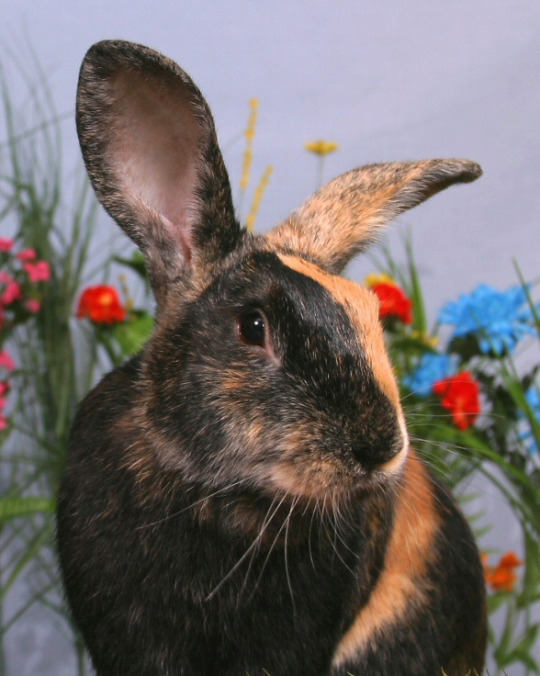

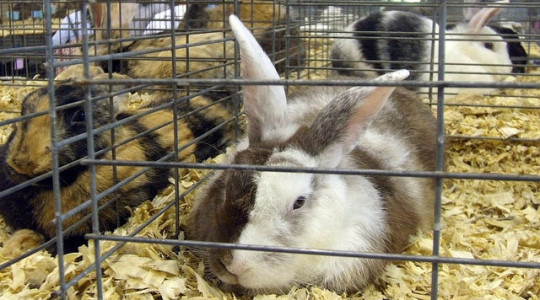
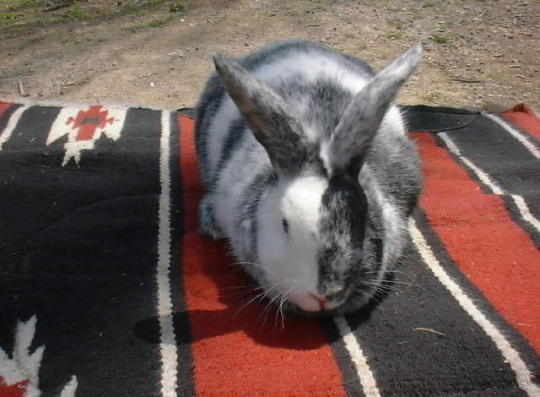
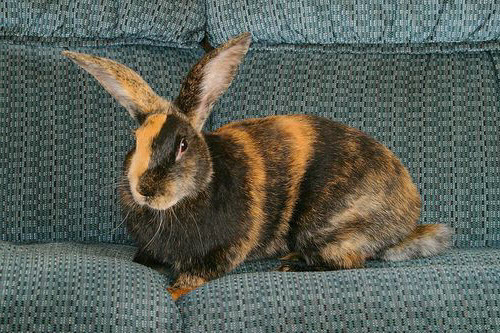

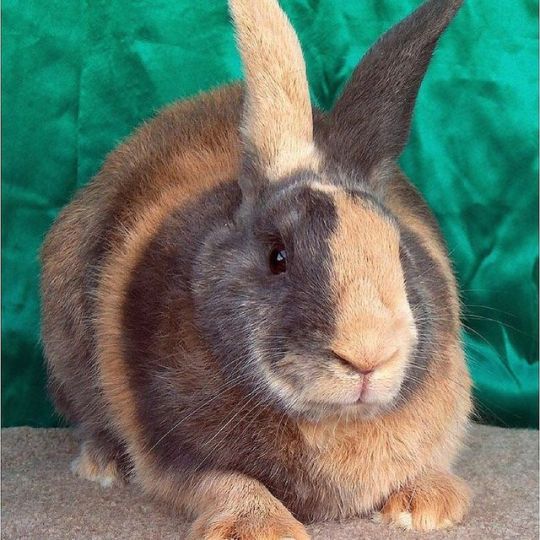

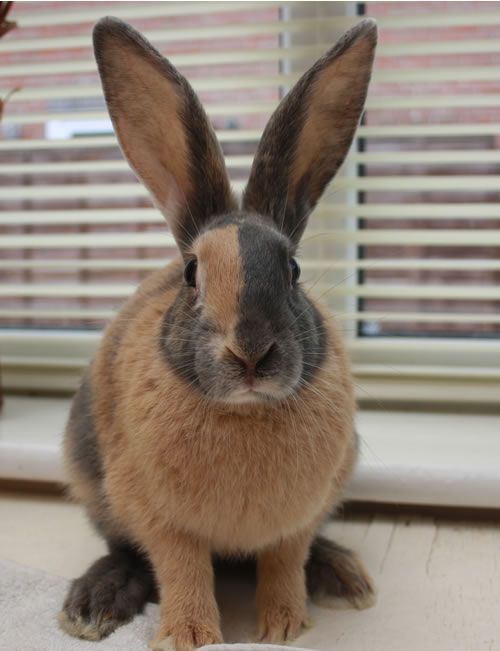
The Harlequin is a colourful breed of rabbit originating from France. It is a breed based around the coloration and markings, rather than fur and body type. The ideal weight of a standard Harlequin is 6.5-8 lbs. It is recognized by both the British Rabbit Council and American Rabbit Breeders' Association. Harlequin rabbits come in two types: Japanese and Magpie. Japanese Harlequins are generally orange and either black, blue, chocolate, or lilac, while Magpie Harlequins are white (instead of orange) and either black, blue, chocolate, or lilac. A "perfect" Harlequin will be split between the two colors on the head, ears, feet, and body.

The current American Rabbit Breeders Association (ARBA) Standard of Perfection calls for a 3 part frontal alternation. The ears are two different colors. The face splits into two colors, which alternate with the ears. The chest and front legs split into two colors, which alternate with the face and match the ears. The hind feet should alternate with the front feet. The body markings are either bars, bands, or a combination of the two. The animal may be disqualified if it doesn't have certain markings on its face etc.
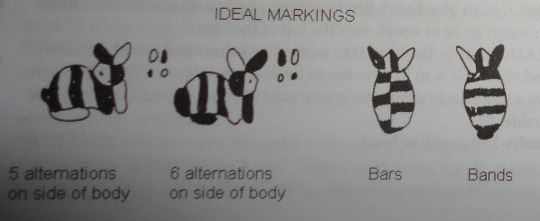

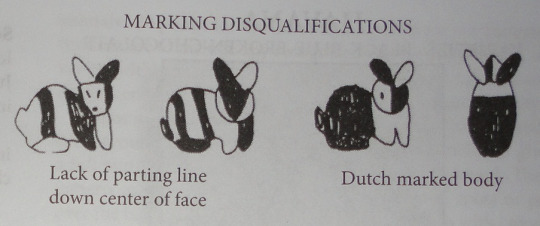
The Harlequin markings do occur in other breeds, but the ARBA does not recognize it as showable in other breeds besides the Harlequin breed.
The Harlequin was first exhibited in Paris in 1887. They were then imported into England a few years later. It was developed from semi-wild Tortoiseshell Dutch rabbits. Originally it looked like a badly marked Dutch rabbit. Harlequins are nicknamed the clown of the rabbits and the royal jester because of the color separations and markings.
The Harlequin rabbit is playful, docile, and intelligent. Like most breeds the rabbit can respond to its own name and even be litter box trained. They are gentle, but like all other rabbits, are high maintenance.
[x]
#bunny abc's#H#harlequin#my favorite rabbit breed#if i ever get back into rabbits it will probably be harlequin#rabbits
77 notes
·
View notes